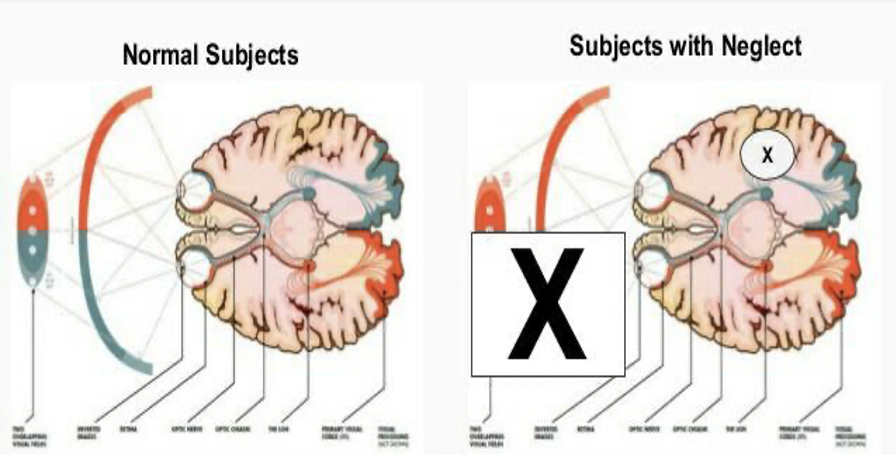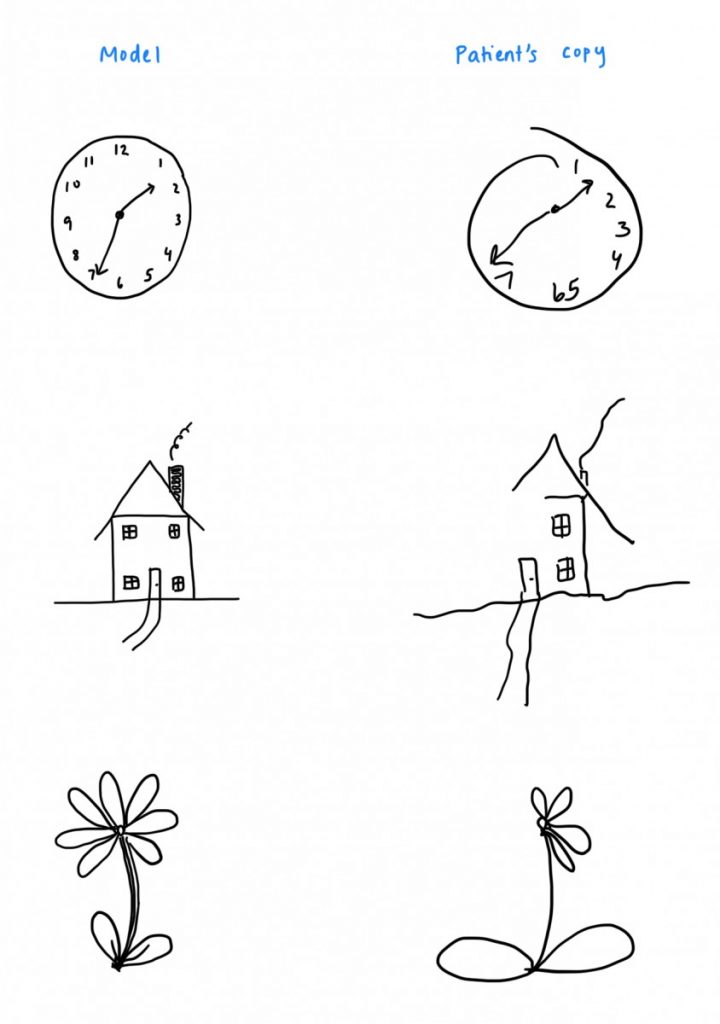Recently in class we watched the documentary, “Secrets of the Mind,” which features scientist V.S. Ramachandran, who is known for his extensive experiments and theories in behavioral neurology. Most popularly known for developing the mirror box, a device created to help amputees who suffer from phantom limb syndrome, Ramachandran also developed theories about blind sight and visual neglect, among others.
I found the visual neglect syndrome particularly interesting and decided to learn more about why/how it occurs. The visual neglect syndrome is a neurological condition in which the side of space opposite of a brain lesion is not recognized anymore. In other words, one’s eyesight can be perfectly fine; however, one half of their visual world doesn’t seem to matter anymore. For example, if an individual has a lesion on the right side of their brain, they will fail to eat food located on the left side of their plate, they may forget to shave the left side of their face or wash the left side of their body. In extreme cases, the person may not even acknowledge that they have a left side; it would be as if it’s not even a part of themselves (Visual Neglect, 2020).
This syndrome is caused by unilateral lesions to the parietal or occipital lobes of the brain, especially in the right hemisphere. Lesions that occur in the frontal cortex and to other various subcortical sites can also provoke visual neglect-like symptoms. However, lesions to the parietal lobe (known as parietal neglect) is the most common cause of the condition so that will be touched on heavily in this post. The parietal lobes in the brain are concerned with a creating a 3D representation of the world around us, allowing a person to walk around without bumping into objects. Thus, when the right parental lobe is damaged, the patient is unable to deal with the left side of the world (Fig. 1).

To see an example of what simple objects would look like to a person with visual neglect, look at figure 1. On the left is a model of the actual object, and when given to a person with the condition, their images look wavy, distorted, and missing some key elements of the image. The image shows someone with damage to their right hemisphere (Fig. 2). Thus, the right side of the images look intact and similar to the model, but the left side is messed up and disfigured.

An interesting fact I learned while doing my research about this condition was in an experiment which showed that patients with neglect aren’t just affected by their surroundings in the real world, but also affected by the world that they created in their imagination (Artificial Intelligence, 2020; Husain, 2008). This experiment included patients whose far space was affected. If one of those patients was asked to close their eyes and imagine standing at the north end of a mall square, he could describe all the details from memory. But he would only list and describe the buildings and objects on his right side, without realizing that there is a whole side to the mall square unaccounted for in his description. If the same person was asked to stand on the south end of the mall square, he would describe the buildings on his new right side (the original left side) and would have completely forgotten about the side he had described before. Scientists figured out that his brain could not handle the left side of space, even in his imagination and memories. Patients in this situation often notice they have given contradictory answers in the experiment but can’t seem to figure out what is wrong. The entire concept of the left side of space has been erased (Artificial Intelligence, 2020; Husain, 2008).
Initially, I thought that visual neglect just results in patients failing to recognize or respond to stimuli on the neglected side. Interestingly however, those objects are not just erased completely from the brain; it is not just a simple mental blank. Turns out, the patient does process information from the neglected side but just doesn’t know it. As an example, a neglect patient can see a house image and answer questions about it, but he is likely to miss the windows or bushes on the right side and when asked to draw the house, he will draw only the right side of it. Then he might say it’s a nice house. The next picture will show the same house but with flames on the left side. Again, the patient will know it’s a house, he will draw the same picture as before and will describe it exactly the same (not mentioning the flames). But if asked about how he feels and his emotions, he will say that there is something wrong with the house and he doesn’t like it (Visual Neglect, 2020).
It’s interesting to see how individuals with visual neglect see and perceive the world. However, it can definitely get frustrating and distressing for a person with neglect since you would know something is off but just wouldn’t be able to connect the dots. Until now visual scanning tasks are used to help visual neglect patients recognize the big picture; however, there is a chance that people diagnosed may have to live with it for the rest of their lives.
References:
- “Visual Neglect”. Cogsci.Ucsd.Edu, 2020, https://cogsci.ucsd.edu/~chiba/VisualNeglect.htm
- https://www.theatlantic.com/science/archive/2016/09/hemispatial-neglect/500000/Color Intelligence. (2020). Retrieved 20 September 2020
- “Artificial Intelligence And Intelligent Search Techniques”. Is.Umk.Pl, 2020, https://www.is.umk.pl/~duch/ref/00/00-how-brain/index.html.
- Masud Husain (2008) Hemineglect, Scholarpedia, 3(2), pp. 3681, http://www.scholarpedia.org/w/index.php?title=Hemineglect&action=cite&rev=170779
Image Reference:
- Iajps.Com, 2020, http://iajps.com/pdf/november2017/20.IAJPS20112017.pdf